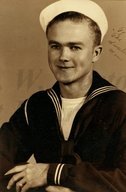
|

|
|
|
|
He was born in Macon, Mississippi, the son of a civil engineer for the Mississippi Highway Department who also sharecropped and milked about forty cows for the Borden Company. "If it hadn't been for the Borden Company we probably would have starved to death," Jack says. He started working at age eleven in a sawmill, earning a dollar for a ten-hour day. He later worked at the ice factory and jerked sodas at a drugstore. Jack graduated from high school in 1942, finished two semesters at the University of Mississippi, and entered the U.S. Navy. After training he was sent to the destroyer, USS Hobson (DD-464), in early 1944. Jack worked in ammunition handling and in fire control while the Hobson screened convoys in cooperation with a carrier, the USS Bogue (CVE-9). On March 13, the Hobson, making contact with a German submarine, dropped depth charges, and sank it. They picked up "sixteen or seventeen survivors," and turned them over to U.S. Army authorities at Casablanca. The Hobson returned to the United States for more convoy duty and to prowl for submarines. It screened an ammunition ship, the Nitro (AE-2) bound for England. Once at Plymouth, England, the Hobson began training for the Normandy invasion. Jack recalls General Dwight D. Eisenhower inspecting the fleet. "He looked at me and I looked at him. And he smiled and I smiled. He didn't say anything and I didn't say anything, but anyway I got to see General Eisenhower," he says. On June 5, 1944, the Hobson went to general quarters around 10 p.m. By morning it was off Utah Beach, when a nearby destroyer, the USS Corry (DD-463) was hit by a mine. The Hobson picked up many of the survivors. "All over everywhere, just ships, ships, ships, ships," is one way he remembers D-Day. The Hobson, running low on ammunition, returned to England about 3 p.m. that day, and then went on radar picket. Later it served in landings at Cherbourg, laying a smokescreen between shore and the USS Arkansas (BB-33). Later returning to the United States, the Hobson was converted to a minesweeper and sent into the Pacific. It cleared the invasion channel at Okinawa, and supported the Marines landing. On April 16, 1945, a kamikaze hit the Hobson while the ship was serving on radar picket. Jack remembers one sailor's death. "I picked him up and put his guts in a bucket. That was our worst day," he recalls. They picked up survivors of the destroyer, USS Pringle (DD-477) and shot down two more planes. He applauds the decision to drop the atomic bombs on Japan. "As a young man and even now as an older man and looking back, I'd say, `Do it again, Harry,'" he states. Jack was discharged in Memphis in February of 1946. Back in college two days later, he graduated in 1948 with a degree in accounting. He worked for a Chevrolet dealership in Macon, and then entered Boy Scouts of America full time. He retired in 1983. |


